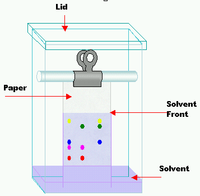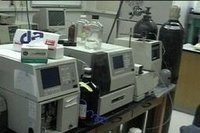Chromatography
|
|
Chromatography is a family of analytical chemistry techniques for the separation of mixtures. It involves passing the sample, a mixture which contains the analyte, in the "mobile phase", often in a stream of solvent, through the "stationary phase." The stationary phase retards the passage of the components of the sample. When components pass through the system at different rates they become separated in time, like runners in a marathon. Ideally, each component has a characteristic time of passage through the system, called a "retention time."
A chromatograph takes a chemical mixture carried by liquid or gas and separates it into its component parts as a result of differential distributions of the solutes as they flow around or over a stationary liquid or solid phase. Various techniques for the separation of complex mixtures rely on the differential affinities of substances for a gas or liquid mobile medium and for a stationary adsorbing medium through which they pass; such as paper, gelatin, or magnesium silicate gel.
Analytical chromatography is used to determine the identity and concentration of molecules in a mixture. Preparative chromatography is used to purify larger quantities of a molecular species. Most of the following refers to analytical chromatography.
| Contents |
History
It was the Russian botanist Mikhail Tsvet (Mikhail Semyonovich Tsvet) who invented the first chromatography technique in 1901 during his research on chlorophyll. He used liquid-adsorption columns to separate plant pigments. The method was described on December 30, 1901 at the XI Congress of Naturalists and Doctors (XI съезд естествоиспытателей и врачей) in St.Petersburg. The first printed description was in 1903, in the Proceedings of the Warsaw Society of Naturalists, section of biology. He first used the term chromatography in print in 1906 in his two papers about chlorophyll in the German botanical journal, Berichte der Deutschen botanischen Geselschaft. In 1907 he demonstrated his chromatogaph for the German Botanical Society. The phenomenon of precipitational separation was observed before Tsvet as well. His contribution was turning the phenomenon into the method of scientific analysis.
The Greek word chroma in chromatography means color in English and refers both to Tsvet's name that is literally translated from Russian as color and to the color of the plant pigments he was separating at that time.
In 1952 Archer John Porter Martin and Richard Laurence Millington Synge were awarded the Chemistry Nobel Prize "for their invention of partition chromatography". [1] (http://www.nobel.se/chemistry/laureates/1952/)
The technology of chromatography advanced rapidly throughout the 20th century. Researchers found that the priciples underlying Tsvet's chromatography could be applied in many different ways, giving rise to the different varieties of chromatography described below. Simultaneously, advances continally improved the technical performance of chromatography, allowing increasingly similar molecules to be resolved.
Chromatography theory
Chromatography is a separation method that exploits the differences in partitioning behavior between a mobile phase and a stationary phase to separate the components in a mixture. Components of a mixture may be interacting with the stationary phase based on charge, relative solubility or adsorption. There are two theories of chromatography, the plate and rate theories.
Retention
The retention is a measure of the speed at which a substance moves in a chromatographic system. In continuous development systems like HPLC or GC, where the compounds are eluted with the eluent, the retention is usually measured as the retention time Rt or tR, the time between injection and detection. In interrupted development systems like TLC the retention is measured as the retention factor Rf, the run length of the compound divided by the run length of the eluent front:
- <math>R_f = \frac{distance\ moved\ by\ compound} {distance\ moved\ by\ eluent}<math>
The retention of a compound often differs considerably between experiments and laboratories due to variations of the eluent, the stationary phase, temperature, and the setup. It is therefore important to compare the retention of the test compound to that of one or more standard compounds under absolutely identical conditions.
Plate theory
The plate theory of chromotography was developed by Archer John Porter Martin and Richard Laurence Millington Synge. The plate theory describes the chromotography system, the mobile and stationary phases, as being in equilibrium. The partition coefficient K is based on this equilibrium, and is defined by the following equation:
- <math>K = \frac{Concentration\ of\ solute\ in\ stationary\ phase} {Concentration\ of\ solute\ in\ mobile\ phase}<math>
K is assumed to be independent of concentration, and can change if experimental conditions are changed, for example temperature is increased or decreased. As K increases, it takes longer for solutes to separate. For a column of fixed length and flow, the retention time <math>(t_R)<math> and retention volume <math>(V_r)<math> can be measured and used to calculate K.
Paper chromatography
See the article paper chromatography
A small spot of solution containing the sample is applied to a strip of chromatography paper about one centimetre from the base. This sample is adsorbed onto the paper. This means that the sample will contact the paper and may form interactions with it. Any substance that will react with (and thus bond to) the paper cannot be measured using this technique. The paper is then dipped in to a suitable solvent (such as ethanol or water) and placed in a sealed container. As the solvent rises through the paper it meets the sample mixture which starts to travel up the paper with the solvent. Different compounds in the sample mixture travel different distances according to how strongly they interact with the paper. Paper chromatography takes some time and the experiment is usually left to complete for some hours.
The final chromatogram can be compared with other known mixture chromatograms to identify sample mixes. Two-way paper chromatography involves using two solvents and rotating the paper 90o inbetween. This is useful for separating complex mixtures of similar compounds.
Thin layer chromatography (TLC)
TLC_black_ink.jpg
In thin layer chromatography or TLC the stationary phase consists of a thin layer of adsorbent like silica gel, alumina, or cellulose on a flat carrier like a glass plate, a thick aluminum foil, or a plastic sheet.
The process is similar to paper chromatography with the advantage of faster runs, better separations, and the choice between different adsorbents. TLC is a standard laboratory method in organic chemistry. Because of its simplicity and speed TLC is often used for monitoring chemical reactions and for the qualitative analysis of reaction products.
TLC plates are made by mixing the adsorbent with a small amount of inert binder like calcium sulfate (gypsum) and water, spreading the a thick slurry on the carrier, drying the plate, and activation of the adsorbent by heating in an oven. The thickness of the adsorbent layer is typically around 0.1–0.25 mm for analytical purposes and around 1–2 mm for preparative TLC.
Several methods exists to make colorless spots visible:
- Often a small amount of a fluorescent dye is added to the adsorbent that allows the visualization of UV absorbing spots under a blacklight ("UV254").
- Iodine vapors are a general unspecific color reagent.
- Specific color reagents exist into which the TLC plate is dipped or which are sprayed onto the plate.
Once visible, the spots can be quantified by way of calculating their Rf values. These values should be the same regardless of the extent of travel of the solvent, and in theory are independant of a single experimental run. They do depend on the solvent used, and the type of TLC plate.
Gas-liquid chromatography
Gas-liquid chromatography is based on a partition equilibrium of analyte between a liquid stationary phase and a mobile gas. It is useful for a wide range of non-polar analytes, but poor for thermally labile molecules.
Ion exchange chromatography
Ion exchange chromatography is a method to separate molecules such as proteins by their charge in a process of ion exchange. Ion exchange chromatography uses ion exchange resins as stationary phase.
Immobilized metal ion affinity chromatography
IMAC is a popular and powerful way to purify proteins. It is based on the specific coordinate covalent binding between histidine or other unique amino acids (either naturally present on the surface of the protein or grafted with recombinant DNA techniques) and various immobilized metal ions, such as copper, nickel, zinc, or iron.
Salt concentration is increased to produce later fractions.
High performance liquid chromatography (HPLC)
High performance liquid chromatography, frequently referred to simply as HPLC, is a form of column chromatography used frequently in biochemistry. The analyte is forced through a column by liquid at high pressure, which decreases the time the separated components remain on the stationary phase and thus the time they have to spread out within the column, leading to broader peaks. Less time on the column then translates to narrower peaks in the resulting chromatogram and thence to better selectivity (it's easier to differentiate one peak from another) and sensitivity (tall, narrow peaks can be easier to discriminate from noise than shorter, broader peaks). Solvents used include any miscible combination of water or various organic liquids (the most common are methanol or acetonitrile). Often, a gradient over time in the solvent composition passing through the column is used to separate analyte mixtures, as a function of how well the changing solvent composition differentially mobilizes the analyte. For instance, using a water/methanol gradient, the more hydrophobic components will elute under conditions of relatively high methanol, whereas the more hydrophilic will elute under conditions of relatively low methanol. Whether one starts with high methanol or low methanol depends on the nature of the stationary phase.
Reversed phase (RP) liquid chromatography
Traditionally HPLC stationary phases are polar, whereas so-called "reverse" phase (RP-HPLC) stationary phases are hydrophobic. On an RP-HPLC column, then, hydrophobic analytes would tend to be retained on the column, eluting more readily as the proportion of the hydrophobic component of the mobile phase is increased. RP-HPLC has lower resolution than GC.
Gel permeation chromatography
Gel permeation chromatography, also known as size exclusion chromatography or Sephadex gel chromatography, separates molecules on basis of size. Smaller molecules enter a porous media and take longer to exit the column, hence larger particles leave the column first. GPC is good for determining polymer molecular weight distribution, but is low resolution.
Affinity chromatography
Affinity chromatography is based on selective non-covalent interaction between an analyte and specific molecules. It is very specific, but not very robust. It is often used in biochemistry in the purification of proteins (or better: protein constructs). These constructs can be of fusion proteins with a so-called his-tag, biotinylated or possibly antigens. After purification some of these tags are usually removed and the pure protein is obtained.
Countercurrent chromatography
See also
External Links
- Library 4 Science (http://www.chromatography-online.org/) online books about chromatography.
- HPLC Find (http://lchromatography.com/hplcfind/index.html) - A directory of HPLC sites on the web, an HPLC search, instrument auctions, conference calendar, liquid chromatography resources, discussion groups, and magazines.cs:Chromatografie
de:Chromatografie es:Cromatografía fr:Chromatographie it:Cromatografia nl:Chromatografie ja:クロマトグラフィー pl:Chromatografia pt:Cromatografia ru:Хроматография sl:Kromatografija sv:Kromatografi vi:Sắc kí tr:Kromatografi


